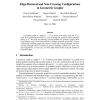144 search results - page 4 / 29 » On the maximum number of edges in quasi-planar graphs |
ENDM
2002
13 years 7 months ago
2002
Given a positive integer n and a family F of graphs, let R(n, F) denote the maximum number of colors in an edge-coloring of Kn such that no subgraph of Kn belonging to F has disti...
DM
2008
13 years 7 months ago
2008
The reinforcement number of a graph is the smallest number of edges that have to be added to a graph to reduce the domination number. We introduce the k-reinforcement number of a ...
COMBINATORICS
2006
13 years 7 months ago
2006
A set M of edges of a graph G is a matching if no two edges in M are incident to the same vertex. The matching number of G is the maximum cardinality of a matching of G. A set S o...
DMTCS
2010
13 years 4 months ago
2010
A geometric graph is a graph G = (V, E) drawn in the plane, such that V is a point set in general position and E is a set of straight-line segments whose endpoints belong to V . W...
GC
2011
Springer
13 years 2 months ago
2011
Springer
The Ramsey number r(H, Kn) is the smallest positive integer N such that every graph of order N contains either a copy of H or an independent set of size n. The Tur´an number ex(m,...

